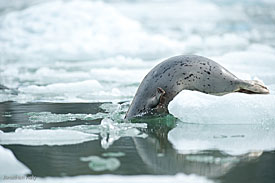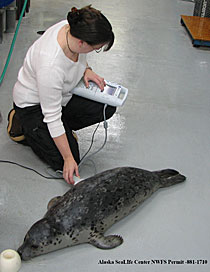Harbor Seal Research
Body Condition Measurements
Deuterium Oxide

Seals store lipids in a subcutaneous blubber layer that functions primarily as thermal insulation, buoyancy and energy reserves. Approximating the amount of blubber stored by individual animals has been accomplished by estimating total body water using hydrogen isotope dilution. We inject deuterium oxide (heavy water) into live-captured harbor seals and compare pre-injection levels of deuterium in the serum to samples collected 2.5 hours after injection.
We can only live-capture seals in one location at a time; thus our samples from different locations are from different times of the year. Harbor seals undergo dramatic seasonal changes in fat content associated with gestation, lactation, molt, and forage availability, and thus percent body fat measurements collected during different seasons cannot be directly compared. To evaluate body condition of seals from different areas, we modeled seasonal variation in body fat, using sternal blubber depth and morphometrics. Our model uses data collected from 874 harbor seals that were subsistence-harvested by Alaska Natives throughout Alaska from 1968–2006. The model allows us to account for the effect of season when comparing populations that were live-captured at different times of year.
Objectives:
- Determine average, minimum and maximum body condition per sex and age class.
- Compare average and minimum/maximum values between populations with differing population trends (i.e., compare a declining population to a population that is stable or increasing).
- Assess other parameters for the animals at the low end of the body fat scale for each cohort (e.g., white blood cell counts, contaminant loads, disease screening, etc.).
This study has been conducted under MMPA NMFS permit #s 358-1585 and 358-1787. Special thanks to the University of Alaska Museum for use of their online database. For additional information concerning this project, contact Shawna Karpovich at (907) 459-7239 or email her at shawna.karpovich@alaska.gov.
Blubber Ultrasound

We are investigating the possibility of using ultrasound to replace deuterium oxide dilutions as a means for collecting body condition measures on harbor seals. Ultrasound would be an attractive alternative because it is non-invasive, requires less animal handling time, requires less preparation and follow-up effort, and is more cost efficient. Although blubber depth measured via ultrasound is frequently used as an indicator of health, it has not been considered for replacement as a predictor of fat and lean mass. We concurrently measured blubber depth via imaging ultrasound at eight locations on each animal and paired this with fat and lean mass predictions gathered from the same seals via deuterium oxide dilutions. These comparisons were obtained for wild seals captured in Glacier Bay, Endicott and Tracy Arms, Southeast Alaska, and for captive harbor seals housed at the Alaska SeaLife Center in Seward. Although most of the ultrasound sites produced strong correlates to fat mass calculated via deuterium oxide dilution, one of the dorsal location provided the tightest fit and it has been concluded that ultrasound can be used in place of deuterium oxide dilutions. These data have the potential for adaptation to other species.

Objectives:
- Determine whether ultrasound measurements of blubber depth are tightly correlated with deuterium oxide dilution measurements.
- Formulate a model to predict body composition using ultrasound in place of deuterium oxide.
This study has been conducted under MMPA NMFS permit #s 358-1585 and 358-1787. The lead on this project is Lori Polasek from the Alaska SeaLife Center. For additional information concerning this project, contact Lori Polasek at lorip@alaskasealife.org or Shawna Karpovich at (907) 459-7239; email: shawna.karpovich@alaska.gov
